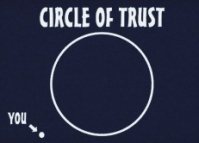“The glue that holds all relationships together – including the relationship between the leader and the led, is trust.” – Brian Tracy
 In the popular remake of the movie Meet the Parents, actor Ben Stiller plays the role of Greg Focker, a man who will be meeting his girlfriend’s parents for the first time. The girlfriend’s dad, Jack, played by Robert DeNiro, gives Greg a lesson on the importance of trustworthiness by teaching him about the Circle of Trust. The idea is quite simple: Inside the circle are people you trust; outside the circle are people that you don’t.
In the popular remake of the movie Meet the Parents, actor Ben Stiller plays the role of Greg Focker, a man who will be meeting his girlfriend’s parents for the first time. The girlfriend’s dad, Jack, played by Robert DeNiro, gives Greg a lesson on the importance of trustworthiness by teaching him about the Circle of Trust. The idea is quite simple: Inside the circle are people you trust; outside the circle are people that you don’t.
One of the most unforgettable scenes is when Jack checks in with Greg to ensure he understands the concept.
As funny as the scene may be, Jack’s Circle of Trust is no laughing matter. Trust is the foundation of every relationship. It influences interactions with our spouse, our kids, our parents, our siblings, our friends, our neighbors, our colleagues, our clients, and yes, even our employees. The more that trust exists, the better the relationship.
Similar to Jack, each of us has a circle of trust. Some people are inside our circle, others are not. Likewise, every employee has a circle. Some bosses are inside the circle, others are nowhere close.
Now ask yourself this, “Are my managers and supervisors in our employees’ circle of trust? Am I?”
If not, you might be in trouble.
Now I know what some of you are thinking: “Employees should be concerned about being in OUR circle. Why should we care about being in their circle?”
Great question.
Employees should be concerned about being in your circle, but trust is a two-way street. It cannot be demanded from employees. You have to earn it, just as an employee has to earn your trust. You don’t give it away to just anyone and neither do they.
In its 2010 Ethics & Workplace Survey, Deloitte concluded that the recession has greatly impacted employee trust – and not for the better. The survey found that 48% of employees who plan to look for a new job when the economy stabilizes cite a loss of trust as a driving force.
And the C-suite knows it, too.
In fact, according to the survey, 65% of executives believe that trust will be a leading factor in voluntary turnover in the coming months.
With employee engagement, employee retention, and expense management a top concern for every company, being inside every employee’s circle becomes part of the organization’s talent management strategy, especially for those with hopes of retaining their top producers.
Question: How do you penetrate an employee’s circle of trust and what strategies do you have for staying there?
I invite you and your leadership team to join me later this summer for ARM Summer School 2011: Creating Supervisor Superstars. The first session of the series addresses topic of trust and provides attendees with strategies for getting—and staying—inside the circle. The class, The SuperPower of Trust: Building Authentic Relationships that Accelerate Performance and Boost Loyalty, will be co-facilitated by industry expert Harry Strausser, III, president of Remit Corp and past-president of ACA International. For more information, please visit www.insidearm.com/superstars.
Gary Jensen is a 12-year veteran of the collection industry and has worked in both first- and third-party collection environments. He is the editor of collector mentor and serves as a trainer, coach, and consultant to the industry. Additional details can be found here.





![the word regulation in a stylized dictionary [Image by creator from ]](/media/images/Credit_Report_Disputes.max-80x80.png)
![Cover image for New Agent Onboarding Manuals resource [Image by creator from insideARM]](/media/images/New_Agent_Onboarding_Manuals.max-80x80_3iYA1XV.png)


![[Image by creator from ]](/media/images/New_site_WPWebinar_covers_800_x_800_px.max-80x80.png)
![[Image by creator from ]](/media/images/Finvi_Tech_Trends_Whitepaper.max-80x80.png)
![[Image by creator from ]](/media/images/Collections_Staffing_Full_Cover_Thumbnail.max-80x80.jpg)
![Report cover reads One Conversation Multiple Channels AI-powered Multichannel Outreach from Skit.ai [Image by creator from ]](/media/images/Skit.ai_Landing_Page__Whitepaper_.max-80x80.png)
![Report cover reads Bad Debt Rising New ebook Finvi [Image by creator from ]](/media/images/Finvi_Bad_Debt_Rising_WP.max-80x80.png)
![Report cover reads Seizing the Opportunity in Uncertain Times: The Third-Party Collections Industry in 2023 by TransUnion, prepared by datos insights [Image by creator from ]](/media/images/TU_Survey_Report_12-23_Cover.max-80x80.png)
![Webinar graphic reads RA Compliance Corner - Managing the Mental Strain of Compliance 12-4-24 2pm ET [Image by creator from ]](/media/images/12.4.24_RA_Webinar_Landing_Page.max-80x80.png)